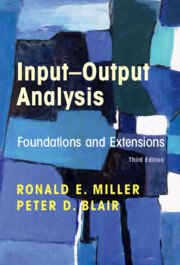Book contents
- Input–Output Analysis
- Input–Output Analysis
- Copyright page
- Contents
- Figures
- Tables
- Preface
- 1 Introduction and Overview
- 2 Foundations of Input–Output Analysis
- 3 Input–Output Models at the Regional Level
- 4 Organization of Basic Data for Input–Output Models
- 5 The Commodity-by-Industry Approach in Input–Output Models
- 6 Multipliers in the Input–Output Model
- 7 Supply-Side Models, Linkages, and Important Coefficients
- 8 Decomposition Approaches
- 9 Nonsurvey and Partial-Survey Methods:
- 10 Nonsurvey and Partial-Survey Methods:
- 11 Social Accounting Matrices
- 12 Energy Input–Output Analysis
- 13 Environmental Input–Output Analysis
- 14 Mixed and Dynamic Models
- 15 Additional Topics
- Postscript
- Book part
- Author Index
- Subject Index
- References
12 - Energy Input–Output Analysis
Published online by Cambridge University Press: 06 January 2022
- Input–Output Analysis
- Input–Output Analysis
- Copyright page
- Contents
- Figures
- Tables
- Preface
- 1 Introduction and Overview
- 2 Foundations of Input–Output Analysis
- 3 Input–Output Models at the Regional Level
- 4 Organization of Basic Data for Input–Output Models
- 5 The Commodity-by-Industry Approach in Input–Output Models
- 6 Multipliers in the Input–Output Model
- 7 Supply-Side Models, Linkages, and Important Coefficients
- 8 Decomposition Approaches
- 9 Nonsurvey and Partial-Survey Methods:
- 10 Nonsurvey and Partial-Survey Methods:
- 11 Social Accounting Matrices
- 12 Energy Input–Output Analysis
- 13 Environmental Input–Output Analysis
- 14 Mixed and Dynamic Models
- 15 Additional Topics
- Postscript
- Book part
- Author Index
- Subject Index
- References
Summary
Chapter 12 explores the extension of the input–output framework to more detailed analysis of energy consumption associated with industrial production, including some of the complications that can arise when measuring input–output transactions in physical units of production rather than in monetary terms of the value of production. The chapter reviews early efforts to develop energy input–output analysis and compares them with contemporary approaches and examines the strengths and limitations of the alternatives commonly used today. Special methodological considerations such as adjusting for energy conversion efficiencies are developed along with several illustrative applications, including estimation of the energy costs of goods and services, impacts of new energy technologies, and energy taxes. Energy input–output analysis is increasingly being applied to global scale issues, such as the energy embodied in international trade of goods and services. Finally, the role of structural change of an input–output economy associated with changing patterns of energy use is illustrated, building on the more general approaches developed in Chapter 8.
Keywords
Information
- Type
- Chapter
- Information
- Input-Output AnalysisFoundations and Extensions, pp. 547 - 600Publisher: Cambridge University PressPrint publication year: 2022
References
Accessibility standard: Unknown
Why this information is here
This section outlines the accessibility features of this content - including support for screen readers, full keyboard navigation and high-contrast display options. This may not be relevant for you.Accessibility Information
- 1
- Cited by
